
Menzion, sometimes Minzion is a small settlement in southern Scotland near Tweedsmuir in the Scottish Borders, in the valley of the River Tweed.

Menzion, sometimes Minzion is a small settlement in southern Scotland near Tweedsmuir in the Scottish Borders, in the valley of the River Tweed.

Menzion lies along the Menzion burn, being separated into Nether Menzion and Over Menzion. Nether Menzion lies at the foot of the burn near the Fruid road. The burn is surrounded on both sides by commercial forestry which is set back to reduce the immediate impact of the acidic run-off. Over Menzion, which was formerly a shepherd's abode, is now abandoned.
Menzion displays evidence of very early habitation with three ancient stones standing on a minor road leading to Fruid Reservoir, just north of the village of Tweedsmuir. Of these, the main stone is known as "The Giant's Stone" which is about 1.60 m high. The two other stones nearby were not mentioned in the Ordnance Survey map of 1859, where the Giant's Stone is described as "Remains of Druidical Temple". The parish records of 1833 state that there were other stones but that these were carried away and put to other uses. [1]
Menzion was part of the barony of Oliver Castle and originally belonged to Clan Fraser. After Sir Simon Fraser died it was divided between his two daughters Joanna and Mary. Joanna married Sir Patrick Fleming and Over Menzion became the property of the Flemings and Mary married Sir Gilbert Hay and Nether Menzion became the property of the Hays. The Fleming family held the lands until 1636, when John (Fleming), second Earl of Wigtown, conveyed Over Menzion to Sir David Murray of Stanhope who obtained a Crown charter on 17 March 1645 incorporating the lands into the barony of Stanhope-Murray. [2]
It was in around 1645 that a vagrant called Marion Chisholm came from Edinburgh while the Plague was raging there carrying a bundle of clothing with the disease in it. The occupants of Nether Menzion and two other farms at Fruid, and Glencotho became infected. Those who escaped the pestilence pulled down the roofs and walls of their houses onto the bodies of those who had died. Marion Chisholm was buried near Nether Menzion in a grave that can no longer be found. [3]
Around this time, Sir David Murray also acquired Nether Menzion which his son William inherited in 1654. [2] The lands eventually became the property of Sir David Murray, nephew of John Murray of Broughton, who was active in the Jacobite rising of 1745. As a result of his participation, the Murray estates were confiscated (as were those other Jacobite sympathisers). Many properties on the Stanhope estate were tenanted by members of the Tweedie family with whom the Murrays had at various times fought or intermarried.

Peeblesshire, the County of Peebles or Tweeddale is a historic county of Scotland. Its county town is Peebles, and it borders Midlothian to the north, Selkirkshire to the east, Dumfriesshire to the south, and Lanarkshire to the west.

Clan Gordon is a Highland Scottish clan, historically one of the most powerful Scottish clans. The Gordon lands once spanned a large territory across the Highlands. Presently, Gordon is seated at Aboyne Castle, Aberdeenshire. The Chief of the clan is the Earl of Huntly, later the Marquess of Huntly.
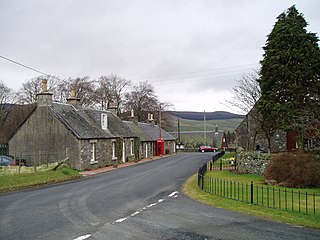
Drumelzier, is a village and civil parish on the B712 in the Tweed Valley in the Scottish Borders.

Tweedie or Tweedy is a Scottish clan name. The Clan Tweedie does not currently have a chief recognized by the Lord Lyon King of Arms and is therefore considered an Armigerous clan. However the surname is also considered a sept of the Clan Fraser. The name is derived from the lands of Tweedie which were along the Valley of the River Tweed in Peebleshire in the Scottish Borders.

Clan Chisholm is a Highland Scottish clan.
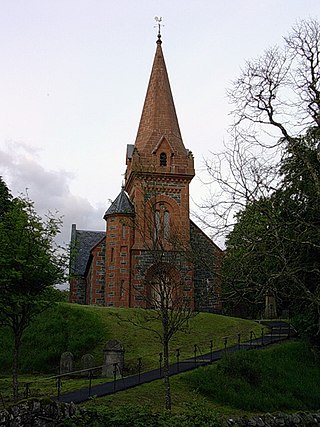
Tweedsmuir is a village and civil parish in Tweeddale, the Scottish Borders Council district, southeastern Scotland.

Clan Ogilvy, also known as Clan Ogilvie, is a Highland Scottish clan. Originating from Angus, Scotland, the progenitor of the Clan received a barony from King William the Lion in 1163. In 1491, King James IV elevated Sir James Ogilvy as Lord Ogilvy of Airlie.
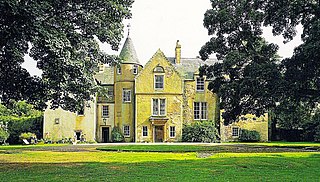
Keith Marischal is a Scottish Baronial Country house lying in the parish of Humbie, East Lothian, Scotland. The original building was an "L-shaped" Tower house, built long before 1589 when it was extended into a "U-shaped" courtyard house. The building acquired its modern appearance in the 19th century when the courtyard was filled in. The house is protected as a category B listed building.

Clan Rollo is a Lowland Scottish clan seated at Pitcairns House, Perthshire. The Chief of the Clan is styled Lord Rollo.

Oliver Castle was a medieval tower house, located in upper Tweedsdale in the Scottish Borders. The site of the hillfort known as Oliver Castle is to the north of the village of Tweedsmuir, although the site of the tower house is less certain. Mentioned in a document of c.1200, it was originally part of the line of peel towers along the Tweed Valley. It was replaced in the seventeenth century by a house, which was itself replaced in the late 18th century by the present Oliver House. For most of its existence the property has been owned by members of the Tweedie family.

Stanhope is a small settlement in the Scottish Borders region. It is situated in the parish of Drumelzier in Peeblesshire, in the valley of the River Tweed.
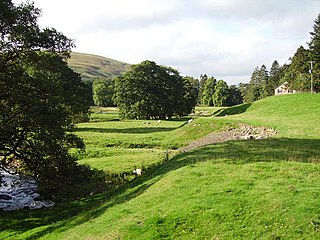
Kingledoors is a group of settlements in a valley in southern Scotland near Tweedsmuir in the Scottish Borders, in the valley of the River Tweed. It is part of the parish of Drumelzier and is bounded on the north by Mossfennan, on the east by Polmood, on the south by the lands of Crook and Oliver.

The Moffat Hills are a range of hills in the Southern Uplands of Scotland. They form a roughly triangular shape with a west facing side, a north facing side, and a south-east facing side. It is 17 kilometres from east to west across this triangle and some 16 kilometres north to south. The highest point is White Coomb at 821 m (2694 ft). The town of Moffat lies just south of the Moffat hills and along with Tweedsmuir, at the northern extremity, is the only centre of population around these hills. In some older maps, the northern part of the Moffat Hills is called the Tweedsmuir Hills, but can also be known by the title Manor Hills.
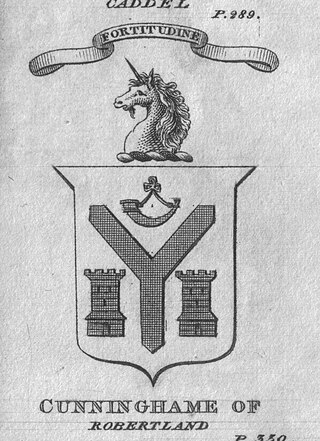
The Castle and Barony of Robertland is located near Stewarton, off the B769 road, in the old district of Cunninghame, Parish of Stewarton, and now part of East Ayrshire, Scotland.

Dawyck Chapel, also known as Dalwick Church, is located within the Parish of Drumelzier in the Scottish Borders area of Scotland. The chapel lies within the Dawyck Botanic Gardens, an outstation or "regional garden" of the Royal Botanic Garden Edinburgh, some eight miles (13 km) south west of Peebles on the B712 and a similar distance south east of Biggar.

Stobo Castle is located at Stobo in the Scottish Borders, in the former county of Peeblesshire. The Manor of Stobo was originally owned by the Balfour family. It became the family seat of the Graham-Montgomery Baronets from 1767. The building of the present castle began in 1805 and was completed in 1811 under the supervision of architects Archibald and James Elliot. It is currently operated as a health spa. The house is protected as a category A listed building, while the grounds are included in the Inventory of Gardens and Designed Landscapes in Scotland, the national listing of significant parks and gardens.

The Lands of Pitcon, previously Potconnel now form a small estate of around 100 acres in the Parish of Dalry, North Ayrshire in the old Barony of Dalry. The present category B listed Georgian mansion house dating from 1787, replaces an older castellated dwelling. Pitcon lies on the outskirts of Drakemyres, now a suburb of Dalry, close to the confluence of the Rye Water, River Garnock, and the Mains Burn, standing on a low knoll. Such a marshy area would have provided a degree of protection to the old castle.
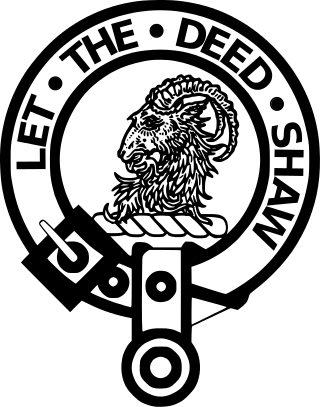
Clan Fleming is a Lowland Scottish clan and is officially recognized as such by the Lord Lyon King of Arms. However, as the clan does not currently have a chief that is recognized by the Lord Lyon King of Arms it is therefore considered an armigerous clan.

The Barony of Stobo is a Scottish feudal barony which takes its name from Stobo in the Scottish Borders.

The Barony of Cowie, Stirlingshire is a Scottish feudal barony that was created in the early 12th century by King David I. In 1563, Adam Erskine, the perpetual Commendator of Cambuskenneth, the head of the Abbey, signed a charter of some of its lands to John, 6th Lord Erskine. Erskine was granted the lands of Cowy, Murtoun and Baddnidayth in the barony of Cowy in the Sheriffdom of Stirling. Erskine later became the Earl of Mar. The original Barony lands were between Cowie and Stirling, starting just north of the town of Bannockburn.